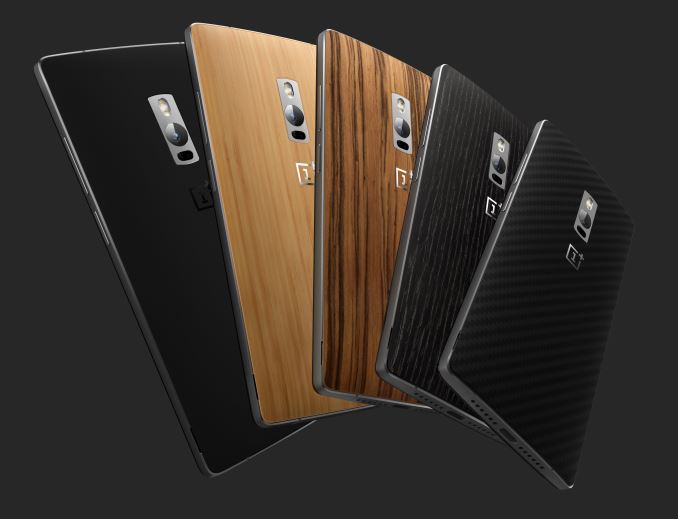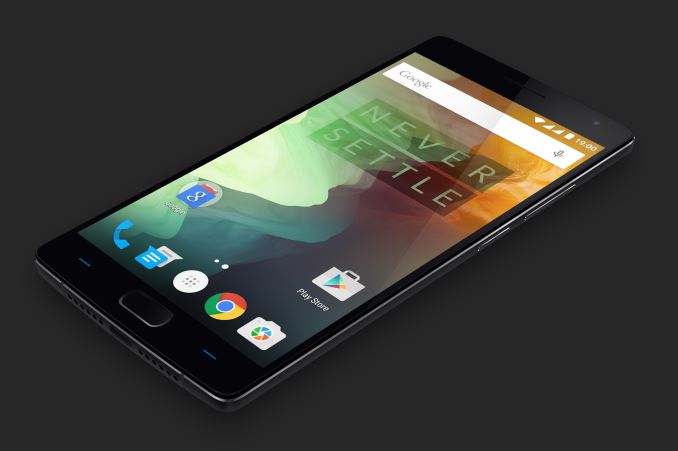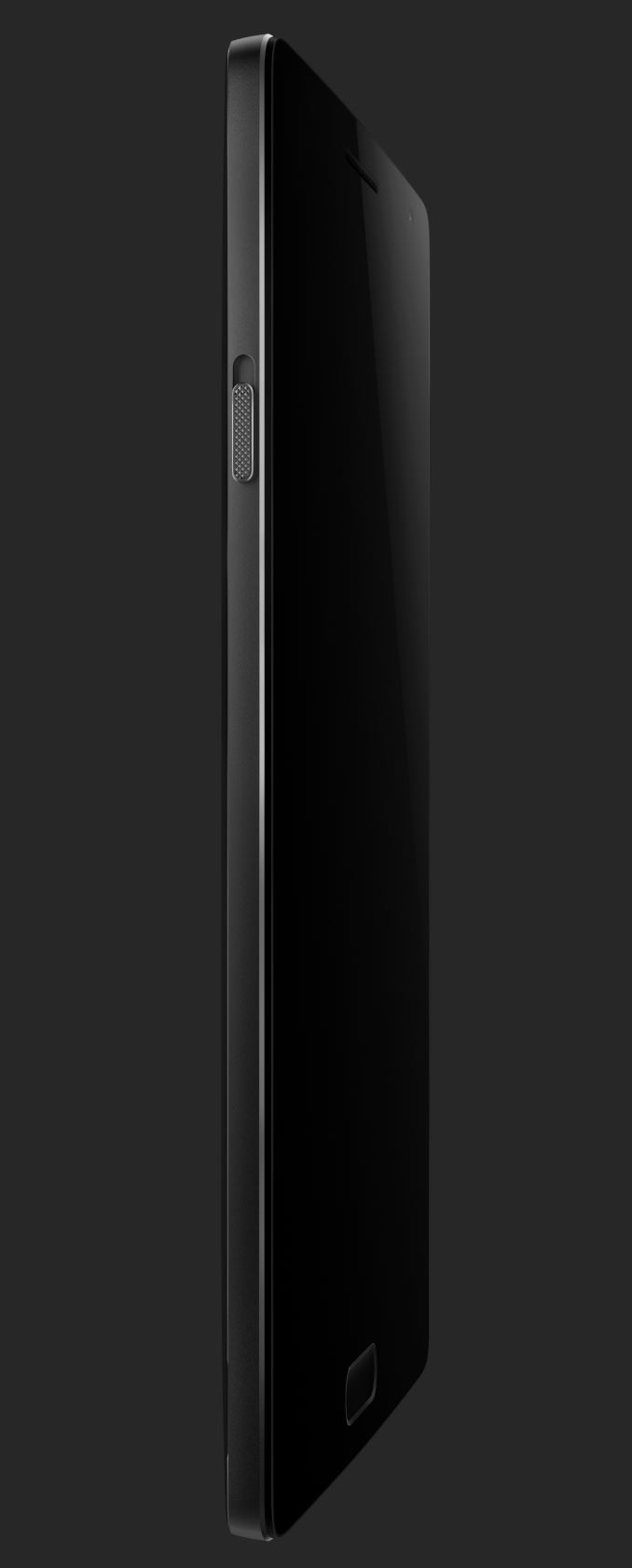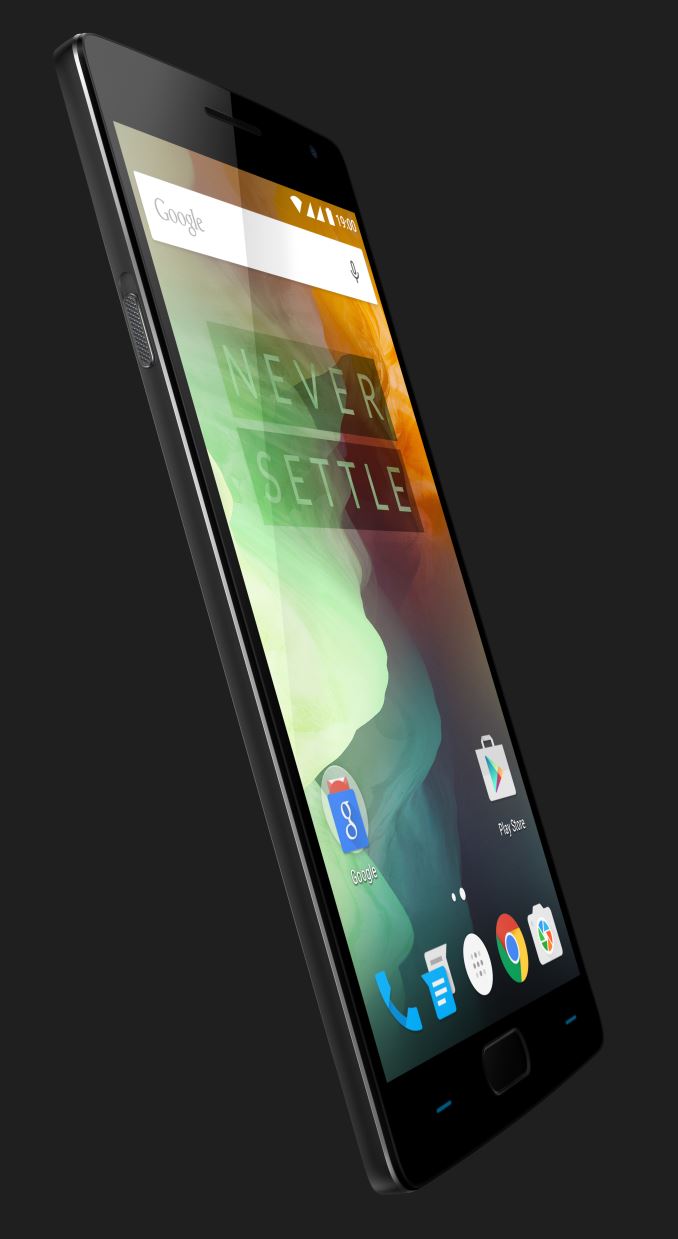OnePlus Announces the OnePlus 2: 389 USD High-End Flagship
by Joshua Ho on July 27, 2015 10:02 PM EST- Posted in
- Smartphones
- Qualcomm
- Mobile
- Snapdragon 810
- OnePlus
- OnePlus 2

OnePlus showed up on the scene last year with a “flagship killer”, the OnePlus One. For those that are unfamiliar with this device, it brought a Snapdragon 801 SoC, 5.5” 1080p display, and some generally impressive hardware at a 350USD price point for the 64GB variant. This made the OnePlus One a pretty incredible value, and to OnePlus’ credit the One remains one of the better choices in the midrange market due to its high-end specs. Today, OnePlus is launching the successor to their first device, which is called the OnePlus 2. To establish some of the basic specifications of this device I would refer to the spec table below.
| OnePlus One | OnePlus 2 | |
| SoC | Snapdragon 801 2.5 GHz Krait | Snapdragon 810 1.8 GHz A57/A53 |
| RAM | 3GB LPDDR3 | 3/4GB LPDDR4-1555 |
| NAND | 16/64GB NAND | 16/64GB NAND |
| Display | 5.5” 1080p IPS |
5.5” 1080p IPS |
| Network | 2G / 3G / 4G LTE (Category 4 LTE) | 2G / 3G / 4G LTE (Category 6/9 LTE) |
| Dimensions | 152.9 x 75.9 x 8.9mm, 162g | 151.8 x 74.9 x 9.85mm, 175g |
| Camera | 13MP Rear Facing (Sony IMX214) f/2.0, 1.1 micron 1/3.06" sensor | 13MP Rear Facing w/ OIS and laser AF, f/2.0, 1.3 micron 1/2.6" sensor |
| 5MP Front Facing | 5MP Front Facing | |
| Battery | 3200 mAh (12.16 Whr) | 3300 mAh (12.54 Whr) |
| OS | Android 4.4 w/ CM11S (At Launch) | Android 5.1 w/ OxygenOS (At Launch) |
| Connectivity | 1x1 802.11a/b/g/n/ac + BT 4.0 (WCN3680), USB2.0, GPS/GNSS, NFC |
802.11a/b/g/n/ac + BT 4.1, USB-C, GPS/GNSS |
| Fingerprint Sensor | N/A | Touch |
| SIM | 1x MicroSIM | DSDS NanoSIM |
| LTE Bands | Global: 1/3/4/7/17/38/40 | US: 1/2/4/5/7/8/12/17 EU: 1/3/5/7/8/20 |
| Launch Price | $299 (3GB/16GB) $349 (3GB/64GB) |
$329 (3GB/16GB) $389 (4GB/64GB) |
As one can see, the display size and resolution is unchanged from the OnePlus One, but OnePlus is promising higher static contrast at 1500:1, relative to the ~1000:1 contrast of the One. This is likely due to the use of photoalignment technology, which seems to have become an industry standard within the past few months. The 1080p resolution is sufficient for a 5.5” smartphone, although an increase to 1440p would be noticeable I suspect that OnePlus is responding to demands for improved battery life over higher display resolutions. The OnePlus 2 also has the somewhat standard Snapdragon 810 for a high-end smartphone, although it’s notable that the maximum frequency of the A57 cluster has been capped to 1.8 GHz in order to improve thermal performance. It isn’t clear if OnePlus is also using hotplug or other mechanisms to only use two big CPU cores either, but this will take a review to really figure out what’s going on. Battery also receives a minor size increase from 3200 mAh to 3300 mAh, presumably at a 3.8V nominal voltage. The lack of microSD expansion likely comes from user experience concerns, as is the non-removable battery. The OnePlus 2 also has a significant improvement to materials, as the frame is an alloy of aluminum and magnesium while the OnePlus One was only made of plastic on the outer casing.
The other major change is the camera. It seems that OnePlus has elected to use a 13MP, 1.3 micron camera sensor with OIS integrated into the module and laser auto focus. The 13MP 1.3 micron sensor is likely to be the OV13860, which means that the sensor format is similar to both the LG G4 and Samsung Galaxy S6, but with a larger pixel size to improve low light performance to reduce read noise from the sensor. Optical stack details remain unknown but the aperture stays at f/2.0 to balance distortion and low light performance. OIS is also introduced to improve low light photo performance for longer exposures. Laser AF is also added to reduce AF speed, a weakness that was present in the OnePlus One. Given the look of this laser AF mechanism, I suspect this is ST-M's time of flight sensor which means that this sytem will be most effective within 10cm of the laser AF sensor.
OnePlus has also introduced some new features in the form of a notification switch, fingerprint sensor, and USB-C port. The notification switch allows for fast switching between all, priority, and no notifications somewhat similar to the iPhone’s mute switch. The fingerprint sensor is also said to be better and faster than the iPhone 6’s TouchID sensor. It’s also purely capacitive, which should make it unlikely to fail over time and you can turn the phone on and unlock it only by using the fingerprint sensor, which would make the experience similar to the HTC One M9+ and Huawei Ascend Mate 7. The addition of USB-C is also great to see, as this makes OnePlus one of the first OEMs to adopt the reversible USB connector standard although it isn’t clear if all of the various features that come with USB-C will be adopted with the launch of Android M.
The OnePlus 2 will be available starting August 11 in select countries for the 64GB storage variant. The 3GB/16GB model will be 329 USD, and the 4GB/64GB model will be 389 USD. StyleSwap covers, which allow you change the back cover’s look and feel, will also be available, with black apricot, Kevlar, bamboo, rosewood, and sandstone black options.














90 Comments
View All Comments
spikebike - Tuesday, July 28, 2015 - link
Highend? More like disposable. Epoxied battery and no wireless charging. What's the point of a high spec phone if it dies with the battery? Why bother with a removable back if you can't change the battery? Seems like style over substance.HideOut - Tuesday, July 28, 2015 - link
look at that price though. Half what a comparable phone with specs similar to that would be.K_Space - Tuesday, July 28, 2015 - link
Disposable is quite the harsh term. My current OPO lasts close to a 2 day mark (no games, but I do use the GPS quite frequently and bluetooth is always on for my MS Band). OPO had one of the fastest NAND when it was released; it ran circles around my M8 at the time. At that price point with 64Gb onboard, I would not complain. Loss of QC would be a major loss however.The performance of S810 (the v2.1 variety) will be interesting to review. Oneplus stated the price bump is predominantly due to the S810 "upgrade", it better be worth it.
K_Space - Tuesday, July 28, 2015 - link
p.s. The OPO battery was easy enough to change. Mine was bought in December so never needed to change the battery, but it's doable:https://www.ifixit.com/Teardown/OnePlus+One+Teardo...
psychobriggsy - Tuesday, July 28, 2015 - link
It's a mid-range phone that has been upgraded with a high end SoC and camera sensor.For someone upgrading from a 2/3 year old phone it will be a significant upgrade.
It's a shame that there is no micro-SD card support, sticking a 64GB card in to get a 128GB device would have been neat. OTOH I only have 48GB total in my phone at the moment and back up the photos and videos that actually use the space.
Also, no Touchwiz/etc either.
Impulses - Tuesday, July 28, 2015 - link
That's debatable, maybe I've got blinders on but outside of camera (which I don't care about much) and battery life (which I do care about) I don't see how it's a very significant upgrade from a similarly priced N5 or Moto X bought two years ago...Almost any phone would have better battery life than those two now, but almost every $350+ phone also has a larger battery because they're ALL physically much larger, which has got to be hurting Android.
SydneyBlue120d - Tuesday, July 28, 2015 - link
What about HEVC encoding? Can You take videos at 1080p60 or 2160p30 or 2160p24 in HEVC format? Is it IOS supported also at higher than 1080p30 resolution/frame rate? Thanks a lot.Mr Alpha - Tuesday, July 28, 2015 - link
Mostly nice specs at a great price. Shame they had to saddle it with the mess that is the Snapdragon 810.Maxpower2727 - Tuesday, July 28, 2015 - link
Unfortunately, until Samsung is willing to start licensing their Exynos SOC to other manufacturers, Qualcomm is pretty much the only game in town.aryonoco - Tuesday, July 28, 2015 - link
The 1+2's major failing is its limited LTE band support.I live in Australia and travel to the US frequently. In Australia we use LTE bands 1/3/5/7/28/40. In the US bands 2/4/12/17 are mostly used. So my ideal phone supports all these bands. Currently the only phones that support a reasonable selection of LTE bands are the iPhone 6 and the Galaxy S6 (the G920F variant). All other flagships such as the LG G4 and the HTC One M9 fail miserably in this regard.
The 1+2 has an even more limited selection of LTE bands than those phones. The North American version is really only good for US and Canada and a few LATAM countries, it will will struggle to get any LTE outside these countries. The Worldwide version has support for LTE bands in Europe and that's about it. It doesn't support band 28 which is used heavily in Australia and New Zealand, or bands 38,39,40 and 41 that are used heavily in China, South East Asia, Africa and some parts of Middle East (calling it Worldwide is a misnomer, it really is a European SKU). If you are the kind of person who travels between say Europe and US, or live in China or Australia, there are no suitable versions of the OnePlus 2.
Sure, I get that it's priced lower than current flagships, but for the same price (or cheaper) I could buy a Sony Xperia Z2 from last year that has much better LTE band support.
The thing is, supporting more LTE bands isn't that expensive. Qualcomm has their Gobi modem which can support over 20 LTE bands in one SKU, which I understand is what the iPhone 6 uses. I doubt that adding more LTE bands would greatly affect the BoM of a device. I don't understand why more manufacturers don't pay attention to this critical aspect of the device. I don't like the fact that as an Android user, I was basically forced to get the Galaxy S6 just for the LTE bands it supports.
It would be great if AnandTech started paying attention to the supported LTE bands as well. You should at least list it in the spec sheet. Being able to connect to LTE is surely at least as important as the fingerprint scanner and laser AF.